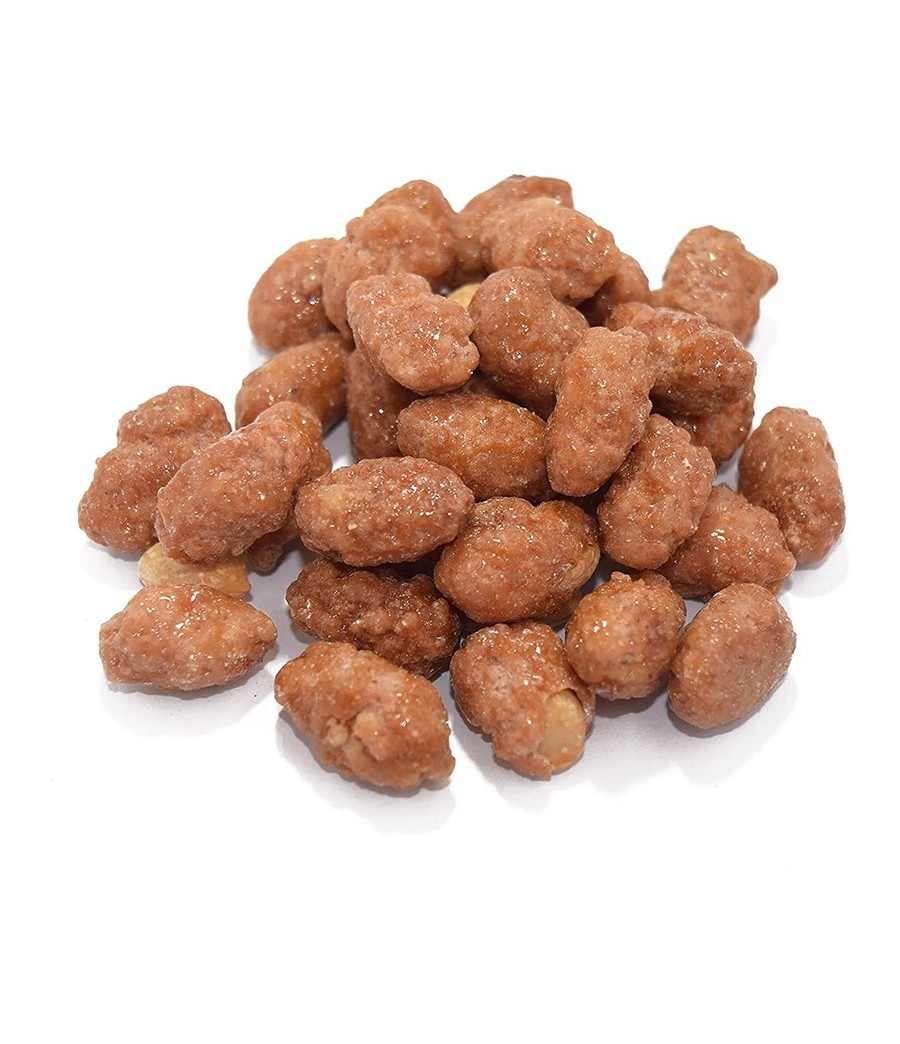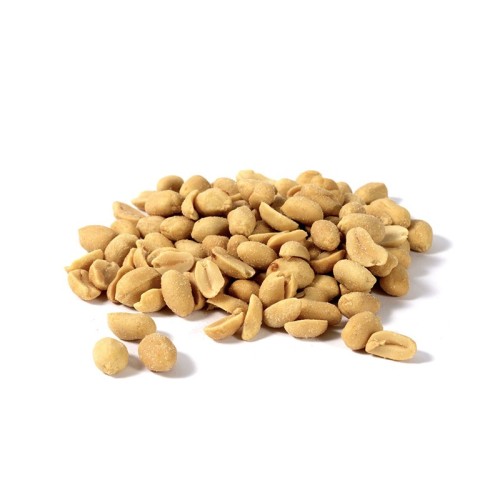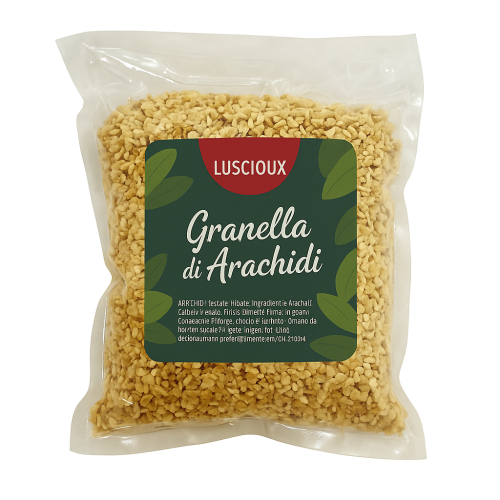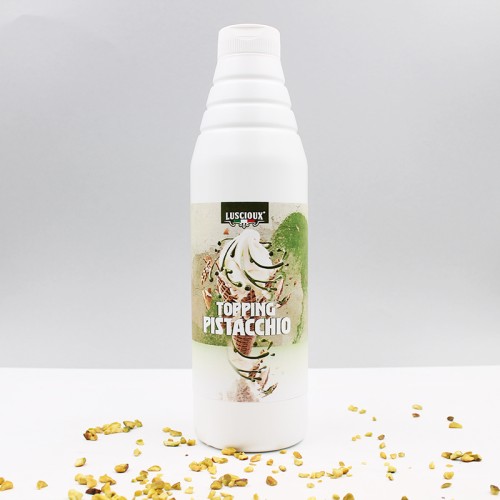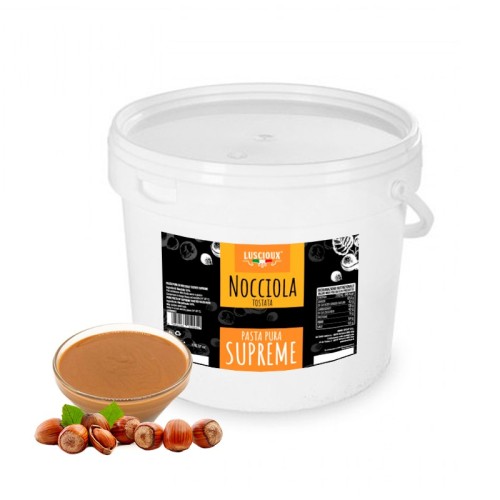Whole Praline Peanuts
(€5.71 Per Kg)
 Security policy
Security policy
Transparency and reliability - Encrypted information (SSL Certificate)
 Delivery policy
Delivery policy
Fast shipping with delivery in 1- 4 working days.
 Return policy
Return policy
24/7
In whole praline peanuts, the flavor is enhanced by the uniform praline. To ensure the best possible quality, the process lasts several hours, in order to ensure uniformity, crunchiness and aesthetics of the final product.
Data sheet
- Product
- Peanuts
Specific References
- ean13
- 8054134415720
Nutritional values
| Ingredients | PEANUTS. May contain traces of NUTS. |
| Method of conservation | Keep in a cold and dry place. |
| Nutrition declaration | average values per 100 g: |
| Power | 2247kJ / 537kcal |
| Fats | 31 g |
| of which saturated fatty acids | 4.5 g |
| Carbohydrates | 47 g |
| of which sugars | 45 g |
| Fibers | 5 g |
| Protein | 15 g |
| Salt | 0.12g |
| Phosphorus | 385 mg (55% NRV*) |
| Manganese | 1.7 mg (85% NRV*) |
| Vitamin E | 9.8 mg (82% NRV*) |
| Source | Euro Company analysis |
| Directions | The advice given IS NOT IN ANY WAY TO BE CONSIDERED OF MEDICAL/PRESCRIPTIVE VALUE. The information provided is for informational and informative purposes only, therefore they are not intended in any way to replace medical advice. In the presence of pathologies you should always consult your doctor. |
| Origin | Egypt |
| Nutrients | Phosphorus, Manganese, Vitamin E |
| Vnr | *Nutritional Reference Value |
| Label and packaging | The images are included for illustrative purposes, the product may undergo changes based on stock availability and the selected weight. |
| Product | Peanuts |
Curiosity
The name "peanut" comes from the Greek Arachos which means sort of legume. Some of its more common names are peanut and groundnut. Peanut is a descriptive term and means "nut in the shape of a pod"; groundnut takes up a part of the vegetative cycle and means "nut under the ground". The peanut belongs to the class of Dicotyledons, to the order of Rosales and to the family of Leguminosae, which includes 40 annual cycle macrothermal bushy herbaceous species, native to tropical countries.
Peanuts are the seeds of a legume whose flowers, after fertilization, are buried forming the fruit that we all know. The best known species, and also the only one to be cultivated, is the Arachishypogaea, characterized by 20-60 cm long, erect or creeping stems; the leaves are alternate, compound paripinnate (two pairs of oval leaflets) with two large membranous stipules placed at the base of the long petiole; the flowers are yellow, solitary whose ovary, after fertilization, due to a positive geotropism mechanism, goes underground to a depth of 2-7 cm (burying of the gynophore). Here it gives rise to an oblong legume, 2-4 cm long, yellowish, with a series of veins, honeycombed, containing 2 or more ovoid and whitish seeds, covered with a thin integument generally brown or purplish-red, which represents the peanut that we all know, also known by the name of spagnolette or American peanuts. The plant can produce over 100 flowers and ripen 20-60 legumes.
Once the peanut was also used as a substitute for coffee and cocoa , currently the main use is found in the industrial production of edible oil, used in the kitchen as an alternative to olive oil. Peanuts are rich in nitrogenous substances, oil, nitrogenous extractives, cellulose as well as vitamin E, copper, phosphorus, magnesium, iron, selenium and zinc. With the increase in the use of peanuts in the food industry in Europe, the cases of allergy or intolerance to this seed are also increasing. It is also contained in baby products, as a component of adapted milk or as a multivitamin excipient. The main allergens are represented by three proteins (Ara h1, Ara h2, Ara h3): these allergens remain stable to heat, so they remain active even after roasting and cooking. Peanut allergy manifests itself early (in 92% of cases between 1 and 7 years) with an incidence of 11.8%, which brings it to third place in terms of diffusion among the population after allergy to milk and eggs however, unlike the latter which can regress, the allergy to peanuts remains for life. The reaction can occur by contact, inhalation and, above all, by ingestion; the symptoms of the allergic reaction are sometimes very severe.
A moderate-fat diet that includes peanuts helps with weight loss. It has recently been demonstrated that hazelnuts and peanut butter are useful elements for the success of slimming diets in which subjects maintain their weight loss even after two and a half years. A careful study was done by Kathy McManus and colleagues at Harvard University's Brigham and Women's Hospital. This study included peanuts and peanut butter as moderate-fat foods (35% energy from fat) in a Mediterranean-style meal plan with a maximum value of 1200 and 1500 calories per day for 101 men and women. . Over the long term, weight loss as a result of the moderate-fat diet was considerably better than that achieved with a low-fat (20% energy from fat) diet. Nuts and peanut butter help reduce the risk of type 2 diabetes. Type 2 diabetes is a growing global problem with huge medical and economic implications. In the UK 3 in 100 people have diabetes and 75% have type 2 diabetes. In the Netherlands more than 440,000 people have type 2 diabetes and the number is growing. In Germany, specialists recently warned that the number of diabetics could reach ten million within ten years.
Generally in Europe there are several million non-full-blown diabetics, i.e. those who have not yet been identified or treated. Simple diets, daily activity, and weight loss are important factors in reducing the risk of diabetes in the general population. As recent research shows, peanuts and peanut butter as part of a balanced diet play an important role. Scientists from the Harvard School of Public Health in Boston, USA, studied the association between nut and peanut butter consumption and type 2 diabetes risk in 83,818 women from the Nurses' HealthStudy aged 34 and age 59, with no history of diabetes, heart disease, or cancer, and with more than 16 years of follow-up. They found that eating nuts and peanut butter was inversely associated with type 2 diabetes risk as a function of age, body mass, family history of diabetes, physical activity, smoking, alcohol and total calorie intake.
The advice given IS NOT IN ANY WAY TO BE CONSIDERED OF MEDICAL/PRESCRIPTIVE VALUE. The information provided is for informational and informative purposes only, therefore they are not intended in any way to replace medical advice. In the presence of pathologies you should always consult your doctor.
Sources
Nutspaper “Peanuts” 2/2008
Nutspaper “Peanuts” 8/2009
History
The identification of the place of origin of the peanut has historically animated a long discussion, since the plant is widespread in three continents: Asia, Africa and America. We must wait for A. De Candolle, in 1855, to resolve the question, the naturalist in fact ascertained the absence of the plant in classical antiquity and in the Arab world and its recent introduction in Senegal, Guinea, East Africa, China and Japan, ending up focusing his attention in the Peruvian-Brazilian area. His theses were supported by the ancient artifacts found in the Peruvian tombs of Ancon, for which he elaborated the hypothesis according to which the plant, from a spontaneous wild form located in Brazil, would have arrived in Guinea by the first slave traders; other transports were operated from Brazil to the islands of South Asia by the Portuguese navigator Magellan (1519-21); subsequently it entered all the other countries where it is cultivated today.
The cultivation then developed greatly in the African context (where, however, it was not known by the Egyptians) so much so that for some centuries peanuts represented the most common food administered to black slaves in the crossing to the New Continent. The introduction of peanuts in Italy dates back to 1772. Today the major peanut producers in the world are China, India, United States, Nigeria, Indonesia, Myanmar (otherwise known as Burma), Chad, Senegal, Argentina, Brazil, Egypt, Israel and Sudan.
Among these, the largest exporters are the United States, Senegal, Sudan, Argentina and Brazil , which alone account for 75% of exports, while China and India , while producing many peanuts, export less than 4% of the total product. The largest importers of peanuts are currently the European Union, Canada and Japan: these three areas alone account for 78% of world peanut imports. The peanut belongs to the class of Dicotyledons, to the order of Rosales and to the family of Leguminosae, which includes 40 annual cycle macrothermal bushy herbaceous species, native to tropical countries.
Sources
Nutspaper “Peanuts” 2/2008
No customer reviews for the moment.

